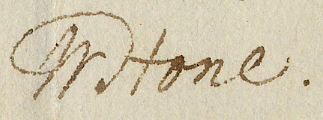Description of the Encoding:
With only a few exceptions, these letters have been transcribed and edited from the originals located in archives in the UK and the USA. (A listing of most of these archives is available Archive Directory located in the Bibliographical section of the BioText.) Each of these letters and documents has been encoded using the tag set available in TEI-Lite (P5). I have used TEI-Lite—rather than the full TEI or a Roma-generated subset—because (a) TEI-Lite is easier to learn and teach than the more extensive markup versions of TEI, (b) TEI-Lite provides sufficient detail for the immediate purpose of this archive which is more presentational than analytic—the aim is to make Hone's correspondence (most of which has never been published) accessible to other readers and scholars—, and (c) as a subset of the more comprehensive TEI tag set, TEI-Lite should be extendable if at some point some scholar wishes to enrich the markup.
One of the key structural decisions in the design of an archive of manuscript transcriptions involves the relationship between "text" and "meta-text." Should the encoded file present a strictly documentary transcription which avoids all editorial commentary and presentational markup? Or should the encoded file weave together both the transcribed original text and the editor's commentary and presentational coding? In the present archive, I have provided commentary, explanatory notes, and links to people and publications, but in the HTML versions (derived from a customized version of the publicly accessible TEI XSLT stylesheets), I have sought to provide a "clean" diplomatic transcription within the "letterbox" frame, leaving headers, notes, and navigational links outside this frame. I have also included at the top of each letter a link to the TEI file so that interested readers can see the XML markup, including the tags and attributes that don't necessarily transfer into the browser-friendly HTML pages.
Editorial principles:
While Hone's handwriting is usually very legible, many of the letters exhibit rather capricious punctuation, frequently with ambiguous dash-like marks standing in places where in more formal compositions one would expect to see commas or periods. In most cases I have left the original dashes, but where the sense of the language demands, I have silently inserted the appropriate commas or periods.
Some of the letters—especially those in the substantial Hone archives at Washington State University, Adelphi University, and the British Library—are clearly either drafts or copies of actual letters. These are typically identifiable by a greater than usual number of erasures and interlinear insertions and/or by the lack of the conventional opening salutations or closing signatures. Often it is possible to deduce from subsequent correspondence that a version of the letter was actually sent, but it is important to bear in mind that the presence of the draft letter does not necessarily guarantee that the letter was actually sent. Because the purpose of the present archive is chiefly to make available an archival record that has never been edited and published, I've tried to render as clear a "reading copy" as I can from the MS. I have not typically tried to mark all the deletions and insertions in the draft letters.
In general, in the TEI encoding the letters themselves appear as diplomatic transcriptions within the boxes on the HTML pages (or, more accurately, within the <div type="letterbox"> tags in XML). These letters are then typically divided into three or four subdivisions:
- <opener> contains date, location, salutation and any other materials at the beginning of the letter,
- <div type="lettertext"> contains the text of the letter itself,
- <closer> contains the signature, and in some letters
- <postscript> contains additional text beyond the signature.
The result is a document tree that looks something like this:
In addition, I have used <ref> tags to identify persons, places, and publications mentioned in the letters. Where possible, the persons and publications are further linked to the relevant bibliography or "who's who" files where readers will find additional information and explanations.
Finally, one additional feature of this edition of Hone's letters may need some explanation. Readers of traditional printed versions of authors' letters will be familiar with the extensive use of footnotes. After all, the letters of a single writer are sometimes difficult to interpret without having a sense of the other correspondents' contributions to the epistolary conversation. As a result, scholars often spend a good deal of time in the footnotes of printed editions of letters, essentially trying to piece together the very local historical circumstances to which the letter writer is responding. The present collection of Hone's correspondence deals with this problem in two ways. First, I have, where it has seemed necessary, included letters written TO Hone as well as letters written BY Hone. (In the letter lists, the letters to Hone are slightly indented.) Second, I plan to write several "Conversation" documents—essentially coherent historical accounts of particular "themes" that emerge within the correspondence. The aim is to produce connected historical narratives that provide the explanatory historical and biographical contexts necessary for an understanding of the individual letters. A kind of prototype of one of these "Conversation" commentaries—describing the formative letters in the friendship between William Hone and John Childs—is accessible here.
